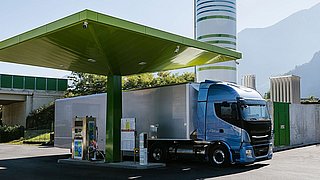
Bio-LNG Initiative
The Bio-LNG Initiative is how dena is supporting the market establishment of liquefied biomethane in shipping and the transport of heavy goods by road. Bio-LNG is a low-emission and climate-friendly fuel with a high energy density.
Bio-LNG is a particularly low-emission and climate-friendly fuel with a high energy density.
The challenge
To date, Germany’s transport sector has fallen far short of its targets for reducing greenhouse gas emissions. In addition, nitrogen oxide limits are being exceeded in many cities and, from 2020, shipping in the North Sea and the Baltic Sea will have to comply with significantly lower limits for sulphur dioxide emissions.
The use of LNG and bio-LNG can contribute to achieving climate protection targets and improving air quality in the short and long term. The release of particulate matter can be reduced by around 95 per cent and emissions of sulphur and nitrogen oxides almost completely. And, although the use of LNG reduces carbon emissions by around 20 per cent at best compared to diesel, the use of bio-LNG reduces carbon emissions by more than 80 per cent.
What we have done:
dena has brought together various partners from the entire value chain and worked with them in the Bio-LNG Initiative in an effort to develop proposals for establishing bio-LNG on the market. The first step depicted the expected market development of LNG in road freight transport and shipping. Accordingly, LNG demand could rise to 35 to 117 PJ in 2030, up from around 1 to 2 PJ in 2020. This was followed by an analysis of the volume potential for the production of bio-LNG based on the potential of biomass and the existing biogas and biogas feed-in plants. As the potential of biogas that can be tapped at the same time is 424 to 697 PJ, this demand can be completely covered by bio-LNG. The production costs and potential savings in greenhouse gas emissions were also calculated for various system concepts. As a result, Bio-LNG is a comparatively favourable option for reducing greenhouse gas emissions in transport, which, if successfully established, has the potential to save up to an additional 7 million metric tons of CO2eq (around 10 per cent of the required GHG avoidance) by 2030.
Measures for the market ramp-up
Instruments have been developed to accelerate the establishment of bio-LNG and increase its greenhouse gas reduction potential, together with the initiative partners. This includes the greenhouse gas quota, as this is the central national instrument for implementing the recently adopted Renewable Energy Directive (RED II). The greenhouse gas quota must be increased by 2030, taking into account both the increase in the volume of biofuels and the planned expansion of electromobility, in order to save additional carbon emissions.
The Bio-LNG initiative also proposes adding a greenhouse gas component to the tolls. The level of the greenhouse gas component would have to be designed in such a way that the administrative effort is also worthwhile for smaller shipping companies.
An exemption from the Renewable Energy Sources Act (EEG) surcharge for the production of renewable LNG would reduce production costs by 4 to 9 per cent and, like investment subsidies or a time- and quantity-limited tender for bio-LNG production volumes, would stimulate investment and accelerate the production of bio-LNG.
Let us know if we can help!
-
 © HoffotografenToni Reinholz
© HoffotografenToni ReinholzTeam Leader, Renewable energies T: +49 30 66 777 - 735 toni.reinholz(at)dena.de











